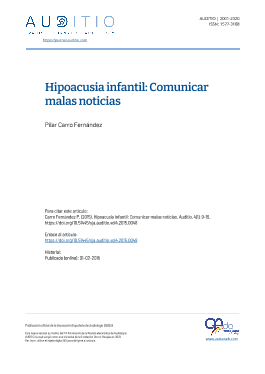Childhood Hearing Loss: Breaking Bad News
DOI:
https://doi.org/10.51445/sja.auditio.vol4.2015.0048Keywords:
hearing impairment , childhood, parentsAbstract
In recent years, the implementation of newborn screening programs for hearing loss has marked a milestone in the field of audiology. Before, when early detection did not exist, the family had time to begin to suspect that their child's hearing was not normal and after the suspicion, the confirmation of the diagnosis of hearing loss was gestated. At present, audiological tests allow us to access the diagnosis without going through these previous stages and deafness usually erupts in an unexpected way. The communication to parents of the diagnosis of deafness in the child should be done with great care. If we are trained in communication strategies we can improve the effectiveness of the message we want to convey. You have to avoid feelings of guilt, show understanding and encourage the appearance of constructive attitudes to face the problem. Only when parents understand what deafness is, when they know its repercussions and accept the limitations, only then will they be able to deal with the problem appropriately.
Downloads
Visibility and Altmetrics
Metrics
Global Statistics ℹ️
|
1561
Views
|
1573
Downloads
|
|
3134
Total
|
|
References
Andréu, Ll. (1996). ¿Qué sentimientos y emociones se dan en la familia de un niño sordo? (II). FIAPAS, 50, 45-47. 1. Andreu, L.l. y Eusebio, P. (1996). ¿Qué sentimientos y emociones se dan en la familia de un niño sordo? FIAPAS, 48, 47-49.
Borrell, F. y Prados, J.A. (1995). Comunicar malas noticias. Estrategias sencillas para situaciones complejas. Barcelona: Doyma
Borrell, F., Júdez, J. y Segovia, J.L., Sobrino, A. y Teresa, A. (2001). El deber de no abandonar al paciente. Med. Clin (Barc), 117,262-273. https://doi.org/10.1016/S0025-7753(01)72081-7
Bukman, R. Communication skills in palliative care: a practical guide. (2001). Neurol Clin, 19(4),989-1004. https://doi.org/10.1016/S0733-8619(05)70057-8
Bukman, R., Baile, W. y Korsch, B. (1988). A practical Guide to Communication Skills in Clinical Practice (CD-ROM or video set). Toronto, Medical Audio-Visual Communications Inc.
Deben, K., Janssens de Varebeke, S., Cox, T. y Van de Heyring, P. (2003). Epidemiology of hearing impairment at three Flemish Institutes for Deaf and Speech Defective children. Int. J Pediatr Otorhinolaryngol, 67,969-75. https://doi.org/10.1016/S0165-5876(03)00186-1
Díaz-Estébanez, E., Salvador, D., Serna, M.J., Vázquez, A., Ferrer, J.C. y Valmaseda, M. (1996). Las personas sordas y su realidad social. Un estudio descriptivo. Ministerio de Educación y Ciencia (M.E.C.). Madrid.
Fallowfield, L. y Jenkins, V. (2004). Communicating sad, bad, and difficult news in medicine. Lancet, 363,312-319. https://doi.org/10.1016/S0140-6736(03)15392-5
Harrison, M. y Roush, J. (1996). Age of suspicion, identification, and intervention for infants and young children with hearing loss: A national study. Ear Hear, 17,55-62. https://doi.org/10.1097/00003446-199602000-00007
Harrison, M. y Roush, J. (2002). Information for families with young deaf and hard of hearing children: reports from parents and pediatric audiologists. En: R. Seewald, J Gravels (Eds.). A Sound Foundation Through Early Amplification, Proceedings of the Second International Conference. United Kingdom: St. Edmundsbury Press; (pp-233-251).
Lina-Granade, G., Morlé, L., Alloisio, N., Edery, P., Plauchu, H, y Truy E,. (2001). Genetic deafness: the primery cause of neurosensorial hearing loss in children. Arch Pediatr, 8,308-12. https://doi.org/10.1016/S0929-693X(00)00201-3
Luterman, D. (1985). The denial mechanism. Ear Hear, 6(1),57-8. https://doi.org/10.1097/00003446-198501000-00015
Pendleton, D, y Hasler, J. (1983). Doctor-Patient Communication. Londres: Academic Press Inc.
Roter, D.L, y Hall, J.A. (1989). Studies of doctor-patient interaction. Annu Rev Public Health, 10:163-180. https://doi.org/10.1146/annurev.pu.10.050189.001115
Sjoblad, S., Harrison, M., Roush, J. y McWilliam, R.A. (2001). Parent's reactions and recommendations after diagnosis and hearing aid fitting. Am J Audiol, 10, 24-31. https://doi.org/10.1044/1059-0889(2001/004)
Stuart, A., Moretz, M. y Yang E.Y. (2000). An investigation of maternal stress after hearing neonatal hearing screening. Am J Audiol, 9,135-41. https://doi.org/10.1044/1059-0889(2000/016)
Suchmann, A.L., Markakis, K,, Beckmann, H,B. y Frankl, R. (1997). A model of empathic communication in medical interview. JAMA, 277:678-82. https://doi.org/10.1001/jama.1997.03540320082047
Tizón, J. (1988). Componentes psicológicos de la práctica Médica. Barcelona: Doyma.
Yoshinaga-Itano, C.H., Sedey, A.L., Coulter, D.K. y Mehl, A.L. (1989). Language of early-and later- identified children with hearing loss. Pediatrics, 102,1161-71. https://doi.org/10.1542/peds.102.5.1161
Yoshinaga-Itano, C.H. (2002). Early intervention of pediatric hearing loss: implications for speech, language and socio-emocional development. 2th Congress of Pediatric audiology. Copenhaguen.

Published
Versions
- 2021-09-15 (2)
- 2015-02-01 (1)
How to Cite
Issue
Section
License
Copyright (c) 2015 Asociación Española de Audiología

This work is licensed under a Creative Commons Attribution 3.0 Unported License.
All articles will be published under the open Creative Commons Attribution (CC-BY) license. This license allows others to share and adapt the content, even for commercial purposes, as long as appropriate credit is given to the authors and the journal. By submitting their manuscript, authors retain copyright but grant the journal the right to make the first publication under this license.
More information about this license is available at: https://creativecommons.org/licenses/by/4.0/
Articles published between 2001 and 2020
The texts published in this journal in the section "AUDITIO 2001-2020" are subject - unless otherwise indicated - to a Creative Commons Attribution 3.0 Spain license. You can copy, distribute, communicate them publicly, make derivative works and commercial uses provided that you acknowledge the credits of the works (authorship, name of the journal, publishing institution) in the manner specified by the authors or by the journal. The full license can be consulted at http://creativecommons.org/licenses/by/3.0/es/deed.es.









